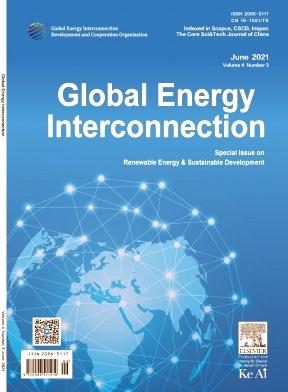基于nsga - ii的频率和电压支持负载资源管理
IF 2.6
Q4 ENERGY & FUELS
引用次数: 0
摘要
确保稳定的频率和电压对现代电力系统来说越来越具有挑战性。这主要是由于可再生能源的波动性和间歇性以及电力需求的不确定性。针对这些问题,本研究提出一种负荷资源管理(LRM)方法来应对突发性电力干扰。LRM方法支持一次频率和电压调节,其与网络动态的集成使负荷参与引起的既定负效用函数最小化。为了获得更好的控制性能,采用基于非支配排序遗传算法ii (NSGA-II)的增益整定程序对LRM进行控制,以提高频率/电压最低点,减小频率/电压稳态误差,使总负载控制工作量最小化。为了验证所提方法的有效性,在MATLAB/Simulink中与三种主要调控辅助业务负载资源管理技术进行了对比实验。与传统的最优负载控制或单独使用LRM相比,改进的基于nsga - ii的LRM具有更优的性能。它实现了更好的频率响应、电压瞬态和稳态响应,同时也考虑了负效用。本文章由计算机程序翻译,如有差异,请以英文原文为准。
NSGA-II-based load resource management for frequency and voltage support
Ensuring stable frequency and voltage has recently become increasingly challenging for modern power systems. This is primarily due to the fluctuating and intermittent nature of renewable energy sources and the uncertain electricity demand. To address these issues, this study proposes a load resource management (LRM) method to cope with the sudden power disturbances. The LRM method supports primary frequency and voltage regulation, and its integration with network dynamics minimizes the established disutility function caused by load participation. For better control performance, a non-dominated sorting genetic algorithm-II (NSGA-II)-based gain-tuning procedure was utilized for LRM, aiming to enhance the frequency/voltage nadir, reduce the frequency/voltage steady-state error, and minimize the total load control efforts. To validate the effectiveness of the proposed approach, comparative experiments were conducted with three load–resource management technologies for primary regulation auxiliary services in MATLAB/Simulink. Compared to the conventional optimal load control or using LRM alone, the improved NSGA-II-based LRM demonstrates superior performance. It achieves better frequency response, voltage transients, and steady-state responses, while also considering disutility.
求助全文
通过发布文献求助,成功后即可免费获取论文全文。
去求助
来源期刊

Global Energy Interconnection
Engineering-Automotive Engineering
CiteScore
5.70
自引率
0.00%
发文量
985
审稿时长
15 weeks
 求助内容:
求助内容: 应助结果提醒方式:
应助结果提醒方式:


